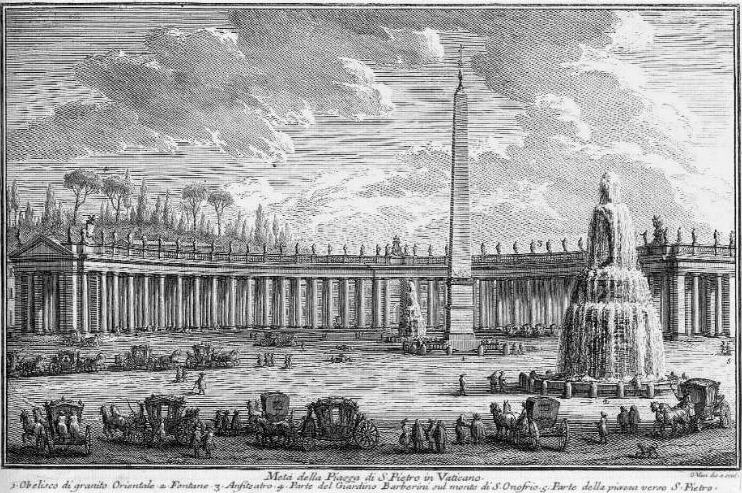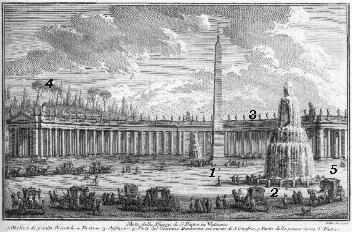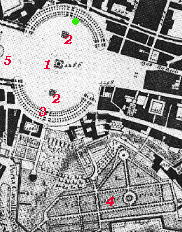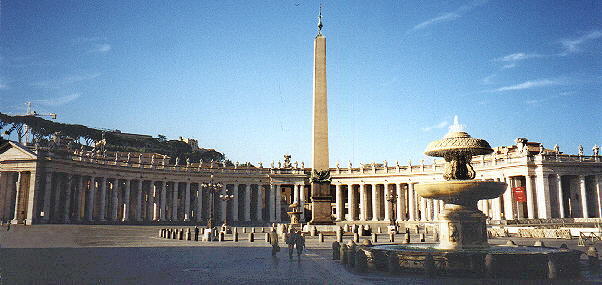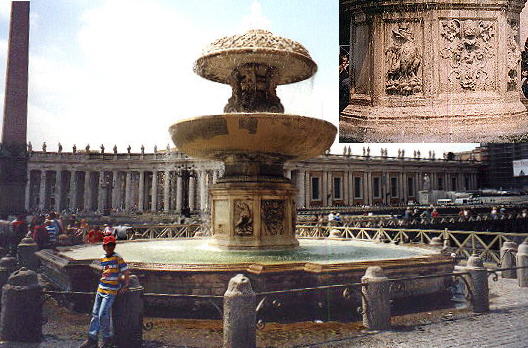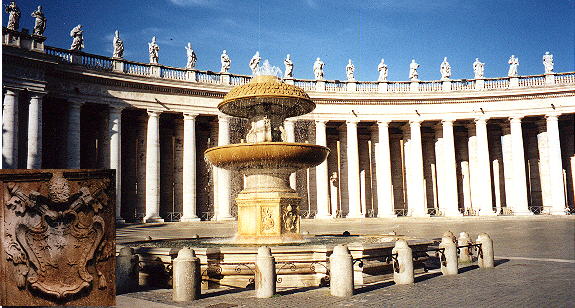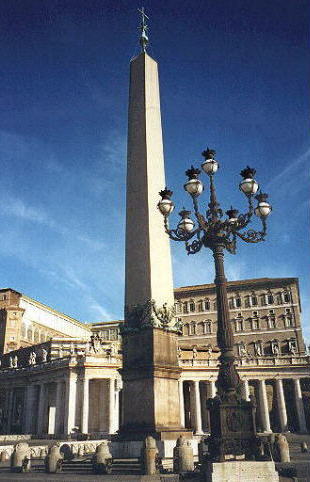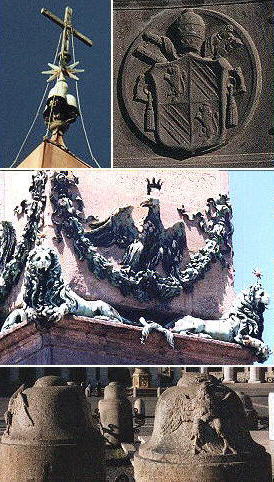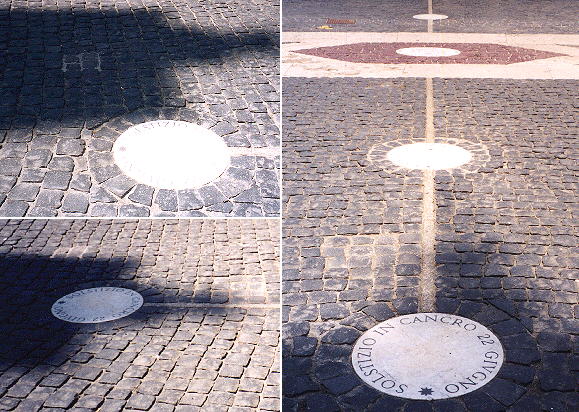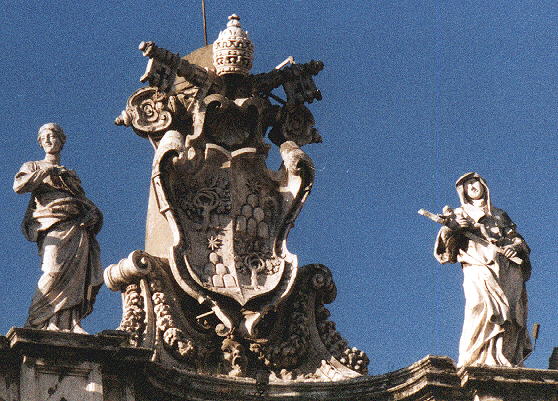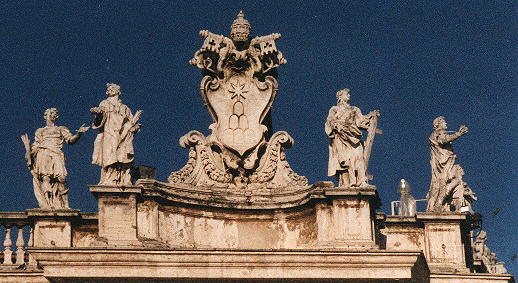

(Metà della) Piazza di S.
Pietro in Vaticano (Book
2) (Map
D2) (Day 8) (View D2) (Rione Borgo)
In this page:
The plate by Giuseppe Vasi
Today's view
The fountains
The obelisk
Coats of arms
The Plate (No. 27)
This is the southern half (metà) of Piazza S. Pietro, less
known than the northern one with the Vatican Palaces. Vasi chose not to show the Basilica to
emphasize the value of the colonnade by Gian Lorenzo Bernini. The view is taken from the green dot in the 1748 map below. In the description below the plate Vasi made reference to: 1) Obelisco di granito orientale; 2) The two fountains; 3) Anfiteatro (the colonnade); 4) Giardino Barberini; 5) Parte della piazza verso S. Pietro. 4) and 5) are covered in other pages.
Today
On a summer early morning the sun lights up the colonnade and the
Piazza is not crowded yet.
Read Charles Dickens's account of 1845 Easter Sunday in this square.
The Fountains
The one on the northern side was the first one to be built by Carlo
Maderno under Paulus V. Some of the small pillars still show the eagle
of the Borghese. The southern side fountain was added by Bernini (who also modified the fountain by Maderno) and completed
under Clemens X.
The Obelisk
Built in Egypt under Augustus, it was moved to Rome by Caligula who
placed it in the Vatican Circus. In 1586 Sixtus V ordered Domenico Fontana
to relocate it in front of St. Peter's. So the Obelisk
was the first element of the Piazza (to see all the obelisks of Rome click here).
The lions, distinguished by a star on the head, are a reference to the
coat of arms of Sixtus V. The eagles on the obelisk and on the small pillars were added by Innocentius XIII. The top of
the obelisk is decorated with the mountains and star of Sixtus V. The lamp bears
the coat of arms of Pius IX.
In 1817, in imitation of Augustus' sundial
in Campo Marzio, the shadow of the obelisk was measured and since then
it serves as a gnomon and its shade at noon indicates the day of the year.
The pictures below were taken on June 19, 2001 and the shadow is just slightly
behind the summer solstice mark.
The Coats
of Arms
The colonnade is surmounted by gigantic coats of arms of Alexander
VII. The one in the centre of the colonnade is a "full" coat of arms of
Alexander VII in the sense that it shows both the mountains and the oaks.
The lateral ones show just the mountains. The one below (south west of
the Obelisk) was included by Juvarra
in his selection on coats of arms. The statues (90) on the colonnade are by
assistants of Bernini, mainly by Lazzaro Morelli and Giovanni Maria de' Rossi. In 1702 Clemens XI decided
to put statues (50) also on the walls with pillars linking the square with the basilica.
Note: More information about Piazza S. Pietro is available in my page It wasn't done in a day (a clue to the decoration of St Peter's).
Excerpts from Giuseppe Vasi 1761 Itinerary related to this page:
Piazza di s. Pietro in Vaticano
Nell'antico campo Trionfale, ove i Gentili apparecchiavano i vani e superstiziosi trionfi, si vede la sorprendente piazza della Basilica
Vaticana, la quale tanto per la vastità e magnificenza, quanto per la distribuzione e decoro de' portici, delle colonne, delle statue, delle
fontane, e dell'ammirabile obelisco egizio, che in mezzo alla gran piazza tiene inalberato il segno della ss. Croce, fa restare
sorpesa l'immaginazione, sembrando opera non umana: perciò volendo io dar conto di ogni sua parte, principieremo dall'
Obelisco Egizio
Nocereo Re di Egitto fece erigere questo obelisco in Eliopoli, e conforme scrive Plinio, di là lo fece condurre in Roma Cajo
Caligola l'anno III. del suo Impero, ponendolo nel Circo Vaticano, che poi fu detto di Nerone per i suoi orti, che quivi erano.
Stette in piedi presso la sagrestia di s. Pietro fino al Pontificato di Sisto V. il quale quì dirimpetto alla Basilica lo trasportò per opera di
Dom. Fontana, ed invece della gran palla di metallo, che aveva nella sua cima, ci pose tre monti, ed una stella, che sono le sue armi, e
sopra collocò il segno della ss. Croce, tutte formate di metallo, la quale avendo per il corso degli anni in qualche parte
patito, nel 1740. fu scesa e ristaurata, ed in tale occasione ci fu posta una particella del legno della ss. Croce; perciò furono
concedute varie indulgenze ai fedeli, che passando la salutassero con un Pater, ed Ave. Questo maraviglioso sasso è
di granito rosso senza cifre, ed è l'unico, che sia rimasto intero dopo le rovine de' barbari, e l'ingiurie de' tempi; è alto palmi 113. e mezzo, e
col piedistallo, e croce di metallo palmi 152. Paolo V. per accrescere ornamento fecevi il fonte a destra, e Clemente X. quello a
sinistra, i quali sono ammirabili non solamente per la copia e deliziosa comparsa delle acque perenni: ma ancora per le tazze
superiori di granito egizio fatte tutte d'un sol masso. Alessandro VII. finalmente col disegno del Cav. Bernini fecevi i maravigliosi portici
in forma di Anfiteatro di ordine dorico, ornato di 320. grosse colonne di travertino con cornici, balaustri, e 136. statue rappresentanti
vari Santi e Sante, di cui la Basilica tiene reliquie, e varj Fondatori di ordini religiosi.
|
Next plate in Book 2: Campo
di Fiore
Next step in Day 8 itinerary: Basilica
Vaticana

Go
to  or to Book
2 or to my Home
Page on Baroque Rome or to my Home Page on Rome
in the footsteps of an XVIIIth century traveller.
or to Book
2 or to my Home
Page on Baroque Rome or to my Home Page on Rome
in the footsteps of an XVIIIth century traveller.
|


